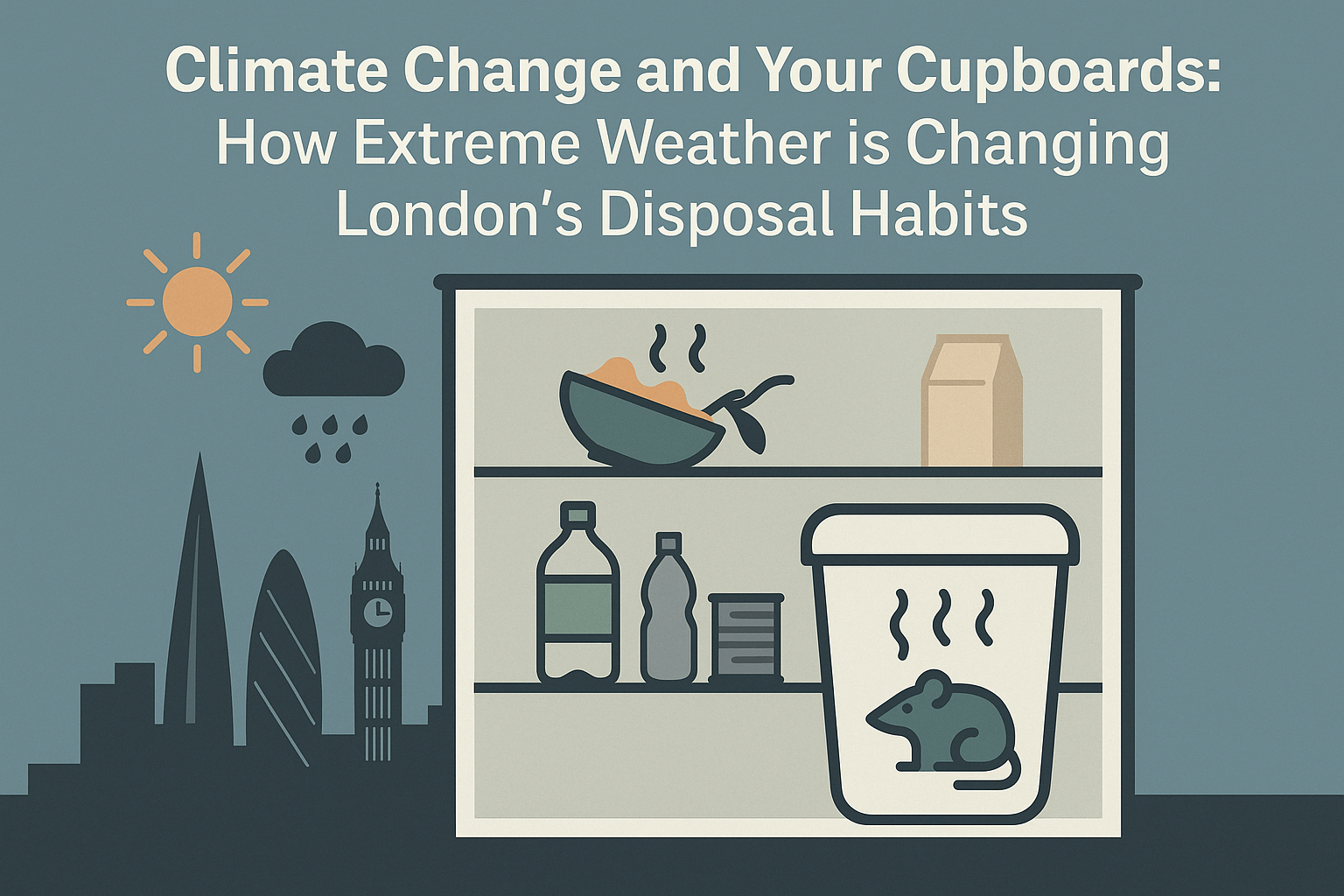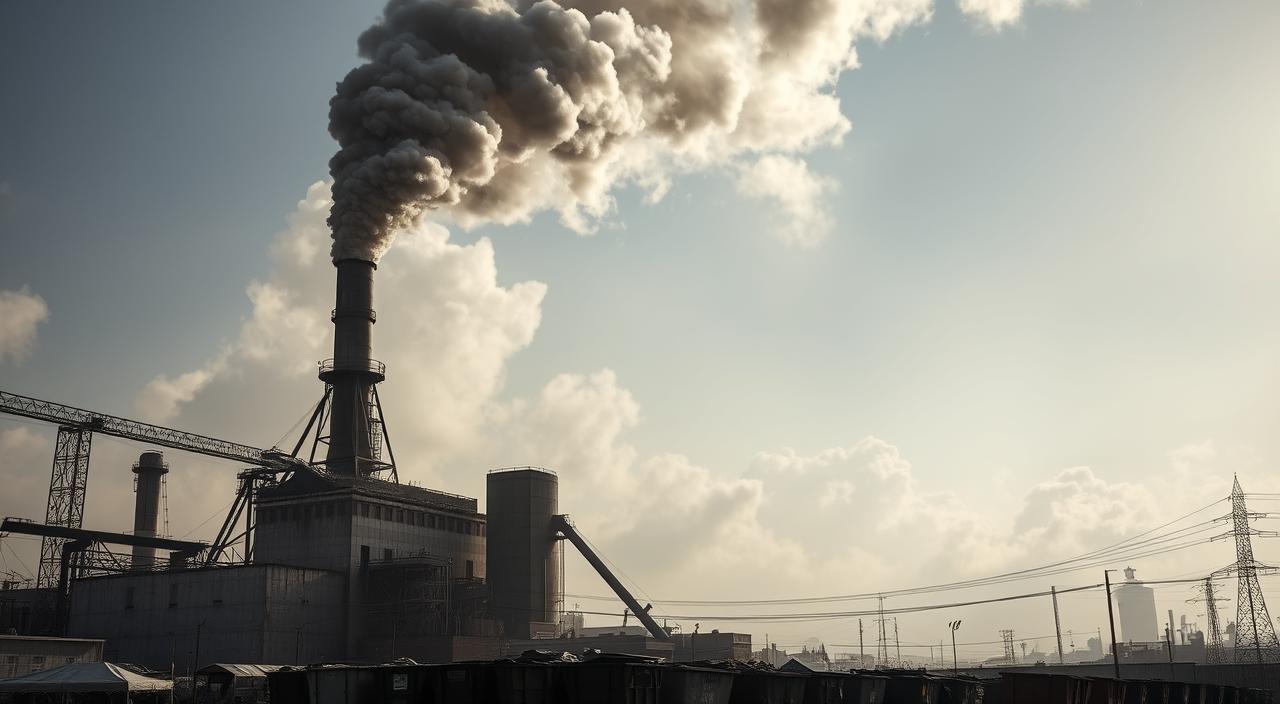
Climate change waste London is becoming a visible challenge in everyday life. Rising global temperatures and unpredictable storms are no longer abstract threats—they affect how rubbish is stored, sorted, and processed across the capital. From food spoiling faster during heatwaves to waterlogged recycling bins during flash floods, extreme weather is changing disposal habits for households, boroughs, and businesses.

This article examines the data, policies, and practical steps shaping London’s disposal systems as the city adapts to the pressures of a warming climate.
Key Takeaways
- Extreme weather is reshaping waste collection and treatment across London.
- There is a steady move from landfill to energy recovery, though emissions remain high.
- Household food waste and single-use plastics increase during hot summers and storms.
- London’s recycling rate (29.9%) is well below the English average of 41%.
- Solutions include better food collections, reduced plastics, and smarter borough contracts.
From Heatwaves to Floods: Weather’s Direct Impact on Waste
Food Waste in Heatwaves
High temperatures accelerate food decay, filling bins with organic waste more quickly. That creates odour issues, attracts pests, and forces boroughs to schedule extra collections.
Floods and Recycling Contamination
Floodwaters ruin paper, cardboard, and packaging set aside for recycling. Waterlogged waste increases contamination, meaning more materials are diverted to incineration instead of reuse.
Weather-Waste Interaction Table
| Event | Immediate Effect | Operational Response |
|---|---|---|
| Heatwave | More food waste; odours and pests | Extra collections; faster depot processing |
| Floods | Contaminated recyclables | Drying facilities; rerouted trucks |
| Combined stress | Overflowing bins; plastic spikes | Resilience planning; public guidance |
Small household actions like meal planning, airtight storage, and careful sorting reduce the stress on borough systems during climate extremes.
Climate Change Waste London: The Data Behind the Shift

A closer look at the statistics highlights the scale of the challenge.
- Household recycling rate (2020/21): 29.9%—far behind the English average of 41%.
- Business waste share (2019/20): Roughly 33% of all material, making it a large contributor to emissions.
- Incineration role: About 3.1% of UK electricity comes from burning refuse, with fossil-like carbon intensity when plastics dominate.
Waste and Emissions Table
| Metric | Value | Implication |
|---|---|---|
| Household recycling rate | 29.9% | Well below targets |
| Business share of waste | ~33% | Raises city emissions |
| Incineration electricity share | 3.1% | Low output, high CO₂ |
Key insight: Burning plastic generates around 175 times more CO₂ than landfilling the same amount, showing why reducing plastic in residual waste is essential.
From Landfill to Energy Recovery: London’s Long Transition
London’s reliance on landfill has declined significantly.
- 1990s: Around 1,500 landfill sites operated nationally.
- 2010: Closure of Mucking Marshes forced boroughs to find new disposal methods.
- Today: England now has 52 incinerators (up from 38 five years ago), supplying 3.1% of UK electricity.
While energy-from-waste plants were promoted as greener than landfill, recent studies show they can emit as much carbon as coal per megawatt hour when plastics dominate the feedstock.
Incineration and Carbon Performance
Feedstock Matters
- Plastic-heavy loads: Very high CO₂ emissions.
- Food to anaerobic digestion (AD): Reduces fossil share at plants.
- Mixed commercial waste: Variable emissions outcomes.
Carbon Capture Limits
Carbon capture remains rare. For example, Ferrybridge captures 1 tonne of CO₂ per day, compared with 500,000 tonnes emitted annually—a negligible scale.
Recycling and Organics: Closing the Target Gap
Recycling Shortfalls
London’s household recycling rate remains stuck below 30%. To reach 50% by 2025 and 65% by 2030, consistent bin systems and clearer guidance are needed.
Organics and Food Waste
Expanding food waste collections and investing in AD and composting reduces methane while producing renewable energy.
Practical Fixes
- Standardise bin colours across boroughs.
- Improve contamination prevention at sorting plants.
- Expand organics processing capacity.
Curious about pricing? Their transparent man-and-van pricing helps you estimate costs instantly.
Recycling Improvements Table
| Issue | Action | Expected Effect |
|---|---|---|
| Low recycling rate (29.9%) | Standardise collections, clearer labels | Higher capture rates |
| Insufficient organics | Invest in AD/composting facilities | Less food in residual bins |
| Mixed rounds | Separate kerbside routes | Cleaner recyclables |
Council Contracts vs Climate Goals
Many boroughs are tied into long-term waste contracts worth over £30bn. These often include “deliver or pay” clauses that require a minimum tonnage of residual waste, making it costly to divert material to recycling.
Solutions:
- Renegotiate contracts to add environmental clauses.
- Create incentive structures for reduced contamination.
- Add phased reductions in minimum tonnages.
Without contract reform, councils risk missing mayoral targets despite household efforts.
Business Waste and the Circular Economy

Commercial activity accounts for a third of London’s collected waste. Businesses have a unique opportunity to drive down emissions through better procurement and separation.
Steps for businesses:
- Provide on-site recycling and food waste bins.
- Include reusable packaging requirements in contracts.
- Use data-led service contracts that tie payments to recycling outcomes.
For more guidance, see the London Circular Economy Strategy.
The Whitechapel Fatberg: Everyday Choices with Big Consequences
In 2017, a 250-metre fatberg weighing 130 tonnes clogged Whitechapel’s sewers. Built up from fat, oil, and wipes, it required weeks of specialist removal.
Household prevention tips:
- Let oil cool before binning it—never pour it down sinks.
- Avoid flushing wipes, even if labelled “flushable.”
- Restaurants should use grease traps to comply with FOG rules.
Thames Water offers further advice on fat, oil and grease disposal.
Conclusion
Extreme weather shows how deeply climate change waste London issues run. Food spoils faster in heat, recycling is ruined by floods, and incinerators emit carbon intensities comparable to coal when plastics dominate.
Key stats underline the challenge: London’s recycling rate is only 29.9%, against a 50% target by 2025 and 65% by 2030. Energy-from-waste supplies 3.1% of UK electricity, but its climate benefit is questionable without better separation of plastics and food waste.
Solutions lie in prevention:
- Reduce single-use plastics.
- Expand food waste collections.
- Standardise bins across boroughs.
- Reform contracts to reward recycling over residual burning.
With households, businesses, and councils aligned, London can turn disposal into a driver of sustainability, resilience, and climate action.

 CALL NOW
CALL NOW